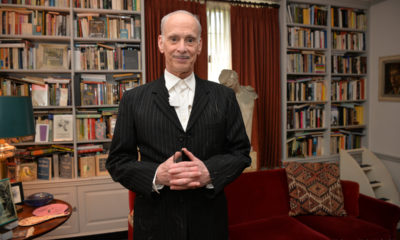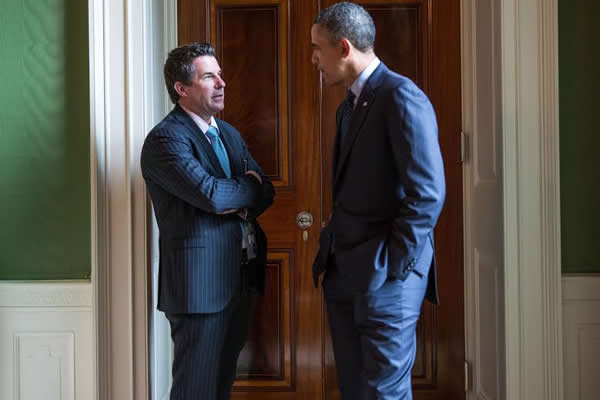a&e features
Actress tells all in ‘Mommie’ memoir
Carol Ann on the shoot from hell and what she’d say to Faye Dunaway today
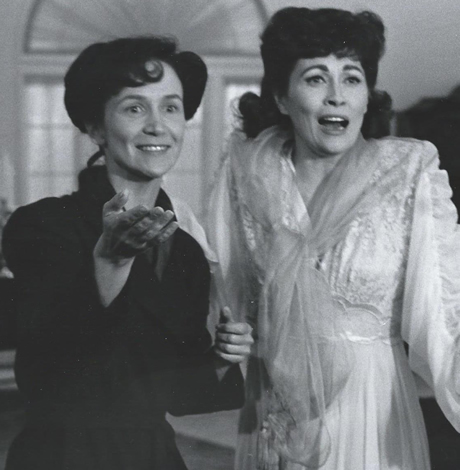
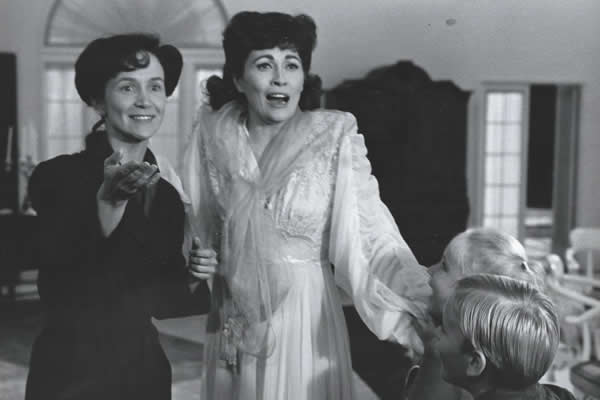
Rutanya Alda, left, with Faye Dunaway, Mara Hobel and Jeremy Scott Reinholt in ‘Mommie Dearest.’ (Photo courtesy Alda)
Editor’s note: this is part two of two of our interview with actress Rutanya Alda, author of”The Mommie Dearest Diary: Carol Ann Tells All.” Part one is here.
WASHINGTON BLADE: Although you don’t hold back at all in your book concerning working with Faye Dunaway, your “Mommie Dearest” co-star, it didn’t feel to me that you had an axe to grind. You write of several moments too where she was gracious — signing photos, posing for photos on set with your brother, when you give her the sweater you made and so on. On the other hand, the book “Mommie Dearest” always felt to me like Christina had a huge axe to grind. Do you agree?
RUTANYA ALDA: I tried to be fair in my book and I hope when Faye reads it she can respect the fact that I was fair to her. … It’s very hard to be with a person on the set who is totally ungiving to the other actor. I just held my tongue then because, as you know from the book, she never stayed for any of my close-ups. I stayed for hers to the 12th, the 13th hour and she never turned around and stayed for any of mine. It’s really not honoring the other actor and we have to honor that. We’re a team working together for the best of the scene. I always felt Faye worked for herself only and that’s the truth. There were private moments when I felt really bad for her … but those moments really didn’t last that long. It’s too bad because, you know honestly, if she had just been gracious (to the crew), they would have embraced her but instead she alienated so many people. When my brother was there as a guest and talked to her, I just got her at a good moment. If it had been a volatile moment, I wouldn’t have dared ask her. The timing just happened to have been right and she was as mellow as she could get. But we were always on pins and needles and you just knew you didn’t want to ask certain things at certain times.
BLADE: Hollywood lore is so full of stories of bitchy star behavior. In your experience, is there always fire where there’s smoke or does some of this get unfairly exaggerated in the public’s endless appetite for such tales?
ALDA: It’s gotten to be so much about me, me, me that some people think the whole world rotates around them and that’s really the worst position for an actor to put themselves in. As Bette Davis said, you’ll meet the same people on your way down as your way up. Fame is fleeting. It lasts for a while. If you have a few years’ run or a decade run, you’re lucky and I think if you can be compassionate and kind, I think that’s a great lesson to give people. I just went to a luncheon at 21 and the coat check girl, so many fairly well known people just throw their coat down and go upstairs and you know, it only takes a second or two to say, “Thank you,” and smile. She remembered me from the time before … just because I treated her like a human being. A lot of stars have come up very quickly and without the experience of being in the industry very long and I think they don’t appreciate the audience as much as they should. A smile or a hello is all you need to give sometimes. Without the audience, you have nothing. …
And the audience of “Mommie Dearest” is a great audience and I think they are disappointed that Faye has never embraced the film. If I were Faye Dunaway, I would have said, “Look, I was great in the part, I did great things. OK, maybe I had an over-the-top performance, but it worked, didn’t it?” But all these years of not talking about it and suddenly after 30 years she’s writing a book? Why? What’s in it for her? Is she doing it for the money? She’s really deprived herself of a great audience of people who love the movie and it’s a detriment to her. Look at all the joy she missed.
BLADE: So you know she is proceeding with her own book?
ALDA: Yes, she has a contract with a publishing house. A friend I know, whom I won’t name unless he names himself, he was just offered to be her ghostwriter. I think she’s gone through several. I e-mailed him and said, “Are you going to do it?” He said, “No, not even if she gives me a million dollars cash would I put myself through this.” So she’s going to find someone from whatever point of view she’s going to do it and I think it’s supposed to be out sometime next year. When she wrote to me, it said time sensitive, she in other words, she probably has a date by which she has to turn it in. Usually it’s a year and a half, then you’re supposed to deliver the book.
BLADE: On his “Mommie Dearest” commentary, John Waters said he thought the film would have worked as straight drama with just some slightly more judicious editing, for instance the scene where you see Diana’s (Scarwid as Christina) panties. Do you agree?
ALDA: (laughs) No. Don’t get me wrong, I love John Waters, I think he’s wonderful, but no, I don’t agree with that. I just ran into an editor who was working on another movie at Paramount at the time and he’d read the script, he’s gay, and he really wanted to edit the film. He loved it and saw it as a camp movie right away and said to Frank, “I want to edit it.” Frank said, “No, you’re the wrong person, we want this to be a big drama,” and I thought, “My gosh, I never knew this.” He said, “You didn’t know it was camp when you read the script?” I said, “No.” He knew right away. But you know, they edited like an hour and a half out of that movie anyway. Some of the takes were really, really long and so much was cut, especially my scenes. I don’t know if it would have changed it but I think it would have made more sense if some of it had been put back, like when my character, Carol Ann, meets Joan and is hired by Joan. I think that would have been a good addition to the story. … But I’m kind of glad the way it turned out because it’s going to continue to have this huge following for years. If it had just been a straight drama, I don’t think we’d be talking today. I think it would have just been one of these movies that was a good movie and then people would have forgotten about it. It’s given people a lot of joy through the years.
BLADE: Do you think “Mommie Dearest” ruined Faye’s career? I know that’s probably an oversimplification, but people say that and it does seem like her filmography is quite spotty after that.
ALDA: I don’t think so. She did quite a few films after it, maybe 10 or 15.
BLADE: Yes, but there was never another “Network” or “Chinatown”-caliber film after it.
ALDA: No, because what did she choose right after “Mommie Dearest”? “Supergirl”? I mean, her choice of material — she still had the power to choose her own material at that point and she was choosing stuff that wasn’t in the same league as “Network,” or, you know, “Chinatown.” I mean these are really great films, really amazing films, and she chooses “Supergirl” and other films you can’t even remember? Even the movie she likes to talk about with Marlon Brando and Johnny Depp (“Don Juan DeMarco”), well that’s not a very good movie. I mean God bless all the actors, but some movies just don’t work. Her choice of parts was really not good. Also I think when one is constantly late on a set and constantly causes production to be slowed down, sooner or later producers just don’t want to lose that money. We went a couple of million dollars over budget because of constant lateness and finally Frank Yablans pulled the plug and we just weren’t going to shoot anymore, that was it. I think today producers won’t put up with that. Show up on time. OK, once in a while, you’re five-10 minutes late, you can’t help it, but not five and six hours late. There’s too much money involved today.
BLADE: “Mommie Dearest” lives on as a camp classic and nobody takes it — at least the film — seriously. Has Joan had the last laugh?
ALDA: Oh, absolutely. Joan Crawford’s career got resurrected. All of a sudden it’s her films that are seen and viewed and she’s kind of the big star here instead of Faye. People are seeing her films. At the Film Forum downtown, there’s a retrospective of her movies next weekend and it’s just amazing. People are rediscovering her that have never seen her movies. I think Joan Crawford has become the big star instead of Faye.
BLADE: Was Joan a good actress?
ALDA: I think she was a wonderful actress for that era. She was over the top and mannered, but that was the movies of that era. I think she was marvelous in those kinds of movies. People don’t act that way today, but they’re fascinating to watch. You look at “Mildred Pierce” and “Baby Jane” and even some of the horror movies she did and she was really pretty impressive. I just saw “Baby Jane” again not long ago and I thought she and Bette were really over the top, but it works. What two actresses today could do that style in that kind of way and make it so memorable and unique? There’s nobody like them.
BLADE: Joan mistook you for Mia Farrow when you were her stand-in on “Rosemary’s Baby” where she was to have had a cameo. Did she say anything after she realized you weren’t Mia?
ALDA: No, she was just very charming. She didn’t come over and say anything afterward but I didn’t go over to her either. She was just standing there, very gracious, and there was something about her that just radiated star. She had been a star for 50 years and she knew who she was.
BLADE: But she didn’t brush you off or anything?
ALDA: No, not at all.
BLADE: You write at length about what a great actor your husband Richard Bright was and it seems like he kind of got swallowed up by the machine, so to speak, with his drug issues. With true persistence and talent, does the cream always rise in Hollywood or have you seen truly talented people fall through the cracks?
ALDA: Unfortunately I don’t think the cream always rises. When I started out 50 years ago, I knew a lot of really, really talented people, much more talented than the people that eventually became stars, I thought, so no. But it’s very difficult because a lot of really talented people are also so sensitive and their sensitivity winds up destroying them. In Richard’s case, he was a wonderful actor, really terrific, as Al Pacino acknowledges. He used to watch Richard work. (Richard was) pained by not working and that’s what really drove him to drugs — the pain from not working and expressing himself. I think so much of it is just luck. I’ve known a lot of people who do it for 10-15 years and they just emotionally can’t take it anymore, the rejection. It’s just such a crapshoot and you don’t know what direction your life takes you. … Look at someone like Phillip Seymour Hoffman. … As painful as that was, I think that opened a little more compassion in people because he was one who did achieve a lot of success. … It’s a very, very difficult business. People shove their kids in front of me and ask for advice for this teenage girl who wants to be an actress. I always say don’t do it if you have any other choice of a career. It’s gotta be in your blood so deep that you can’t do anything else. … Enjoy your life. Life is short. Being an actor is like having a virus you can’t get rid of.
BLADE: Do you wish you had left Richard sooner?
ALDA: Well I loved my husband a lot. … He was a good person, a very generous person. I just had no idea what his addiction meant and that it was so hard to break that chain. I didn’t understand that you can’t do it for them. …. This was the ‘80s and there was a lot then we didn’t fully understand. I think later when the Betty Fords and other programs, there was more understanding, but this was the early ‘80s.
BLADE: Do you think Christina wrote her book just to get back at Joan for being left out of the will?
ALDA: No, because I think the book was already more or less written before Joan died. Now, did Joan leave her out of the will because she knew she was writing a book? I don’t know, maybe. But the book was done before the will. Had it been the other way around, I might have said yeah. It was a scandalous thing to do at the time because she was the first to do it, the first to write and sort of reveal her life with a major star. Later one of the Crosby kids wrote about Bing Crosby and Bette Davis’s daughter wrote about Bette Davis, but she was the first.
BLADE: Had you read the book when it came out or did you read it when you got the part?
ALDA: I read it when I was getting ready for the film, I’d heard about but didn’t read it until I was cast.
BLADE: Why did Christina never visit the set? I would have thought she’d have been at least curious.
ALDA: She told me the script was totally different and she just wanted to let it go. She and her husband, David Koontz, had written a script that was rejected so after Frank and Frank took over, she just felt she’d sold the rights, it was going to be what it was going to be and it was out of her hands so she had not interest in visiting the set.
BLADE: Why did you choose the self-publishing route for your book?
ALDA: I’d had it with an agent for almost two years and I just felt he wasn’t getting it out to the right people. I could have tried to find another agent but I thought, OK, that could be another two years. I learned things happen rather slowly in the publishing world, at least from my experience, and I felt this was the right time to put it out. Actually Christina Crawford was one person who encouraged me to self publish because she had done it after “Mommie Dearest.” … I thought, well, at least that way we’ll get it out into the world and I won’t be waiting and waiting and waiting. I’m glad I did it because at least I beat Faye.
BLADE: You write of how painful the makeup was on the film. How long did it take your face to fully heal after the film?
ALDA: About a month. Things are better with appliances now, but at the time with all that glue on your skin, it was really sore and red and tender.
BLADE: You said you knew of the film’s camp element immediately upon seeing it, but did you realize the gay element in that then too or did that come later?
ALDA: I didn’t really know that then, no. I think my first inkling to that was when I did the Town Hall show Mother’s Day with Joan about 10 years ago with Lypsinka, who is absolutely brilliant. Then, of course, about three years ago there was a show with Hedda Lettuce. She said, “Do you have any stories from ‘Mommie Dearest,’” and I said, “Yeah, I kept a journal.” She said, “Could you come read something from it,” so I went and read a few things. Then Marc Huestis called me two years ago and asked me to come to the Castro to read from it. I said, “Do you think anybody would be interested?” He said yes, so then at the Castor there were like 1,500 beautiful gay men and honestly just this wave of love that hit me and, wow, I still feel it in my heart, this love and support that came from the audience. I’m very emotional about it still. I read from my diary and they just went wild, they were so wonderful. So they were the first real audience and I thought, oh my God, I’ve got to publish this book. It hit me that people were really interested.
BLADE: Did you read Faye’s autobiography “Looking for Gatsby”?
ALDA: No. I went to Barnes & Noble to look at it. I thumbed through it but there didn’t seem to be much on “Mommie Dearest” so I didn’t buy it.
BLADE: What would you say if you were in an elevator with her?
ALDA: Hi. But she might not answer me because there were a lot of times on the set when she’d just walk right by. I’d be prepared for that.
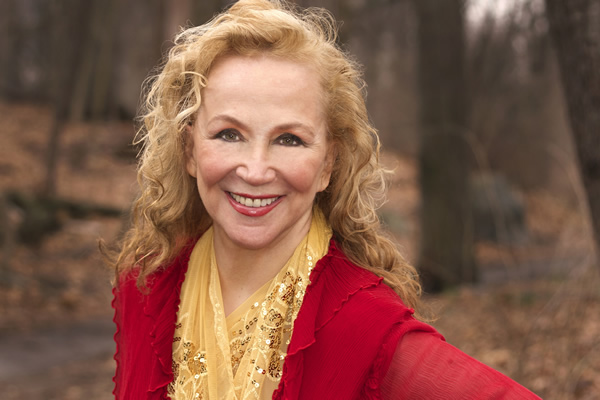
Rutanya Alda today. (Photo courtesy Alda)
a&e features
Have yourself a merry John Waters Christmas
Annual holiday show returns to Alexandria and Baltimore
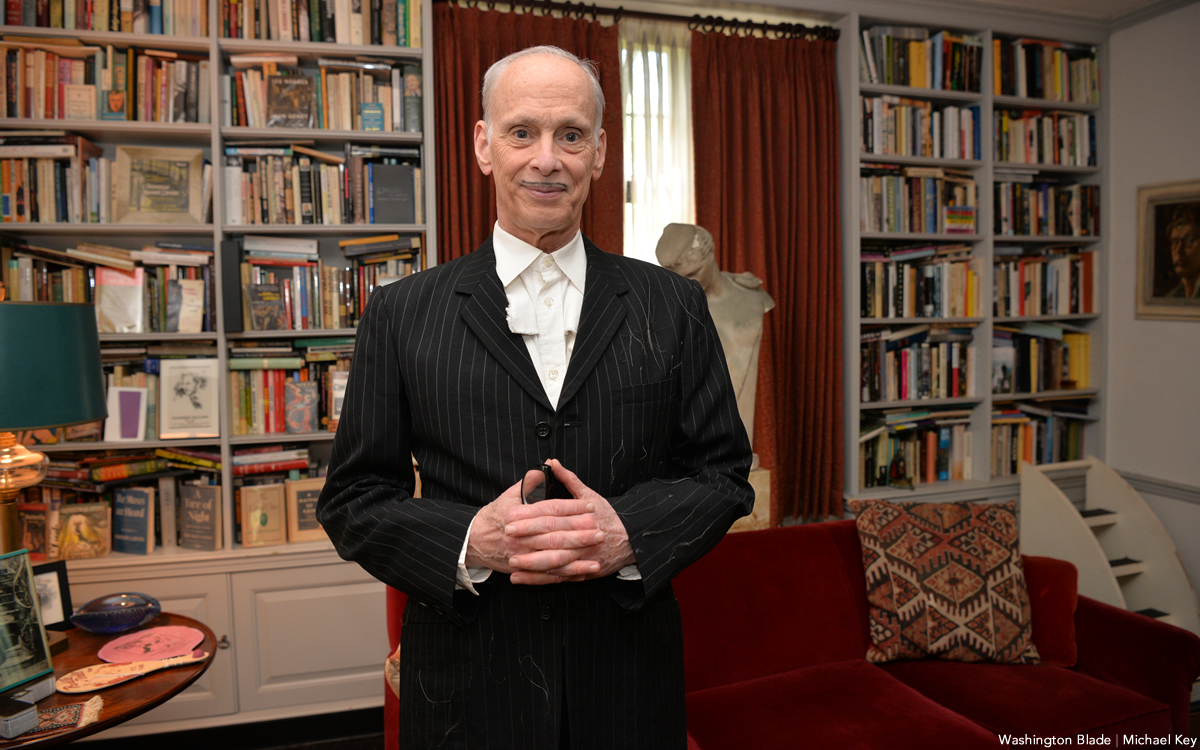
When it comes to iconic Christmas scenes in movies, none can top the tree-toppling tantrum thrown by cha-cha heels-deprived Dawn Davenport in John Waters’s fifth full-length feature “Female Trouble” from 1974. Therefore, it’s not surprising that Waters continues to make art out of Christmas, performing his spoken word Christmas tour in cities across the country. Waters has even more reason to celebrate with the release of his new red vinyl 7” single, a cover of Little Cindy’s “Happy Birthday Jesus (A Child’s Prayer)” on the A-side, and “A Pig Latin Visit From St. Nicholas” on the B-side. If you’re still looking for unique Christmas gifts, consider this record. As always, John was kind enough to make time for an interview in advance of his tour dates.
BLADE: John, in preparation for this interview with you, I went back and listened to Little Cindy’s original rendition of “Happy Birthday Jesus (A Child’s Prayer)” on your “A John Waters Christmas” CD.
JOHN WATERS: One thing I did, if you notice, I make the same stumble in my recording that she did in the original.
BLADE: It sounded to me like she got choked up.
WATERS: No, I think she just stumbles over a word, so I stumbled over the same word. It’s appropriation, insanely.
BLADE: Is this a song you first became aware of in your youth or when you were an adult?
WATERS: When I was doing the Christmas album, I had this friend named Larry Benicewicz. He was kind of my idea man with music. He knew every single old record. I would say to him, “Weird Christmas songs,” when we were doing a soundtrack, or a song about bears, or a song about this, and he would give me all these tapes. It was one of the ones he played for me. A lot of the songs I put in my movies and on my records, I did know as a kid. I did not know this one, but I immediately embraced it. I don’t think it’s campy. I think it really is spiritual in a weird way. My doing it makes it a novelty record. I am really for novelty records, and there aren’t any anymore. Why was there not a COVID novelty record? That’s insane. The dance “The Bug” that’s on the “Hairspray” soundtrack would be perfect for COVID.
BLADE: The thing that struck me was that for a Christmas song in the voice of a child, a kind of death pall hangs over it, with lines like, “If I was good you’d let me live with you” and “they nailed you to the cross, they wanted you to die.”
WATERS: All of it! When I see children at midnight mass kneeling in front of a nude man nailed to a cross, I feel like I’m at The Eagle! It is S&M, it’s creepy. I took the same cover (photo) from her record to parody and put my face on it. The same thing I did with The Singing Dogs last year when I covered (their version of) “Jingle Bells.” I’m really into novelty records. I love them and I’m trying to bring them back. I don’t expect anybody to ever play these records. Even The Singing Dogs one said on it, “Please do not play this record” [laughs]. And the flipside, the Pig Latin version, is almost impossible to listen to.
BLADE: I’m so glad you mentioned that. “A Pig Latin Visit From St. Nicholas” reminded me of the lost art of speaking in Pig Latin. I also recall watching the PBS series “Zoom” as an adolescent and learning to speak “ubbi dubbi,” a distant relative of Pig Latin. Do you think that the time is right for a Pig Latin or ubbi dubbi revival?
WATERS: Here’s the thing, I never could pick up any language, except Pig Latin. I’ve been in every foreign country. Foreign countries have given me money to learn to speak the language. I can never do it! But Pig Latin…my parents and other parents in the ‘50s spoke Pig Latin so kids couldn’t understand what they were saying. Then my mother taught it to me, and I used it. The hardest take to shoot in “Pink Flamingos” was not eating the dog shit. It was when the cast skipped, in one take, saying “E-way, are-yay e-they ilthiest-fay eople-pay in-hay e-they ole-hay ide-way orld-way.” We’re the filthiest people in the whole wide world in Pig Latin. We had to do so many takes so they could do it once without screwing it up. In “Polyester,” Edith (Massey) answers the phone, “ello-hay.” I did a photo piece where it was all subtitled in Pig Latin. Like “osebud-Ray” (from “Citizen Kane”) or in “Streetcar,” “ella-Stay!” [Laughs] All the iconic dialogue translated into Pig Latin. My assistant who helped me do it, had never heard of Pig Latin. She really got good at it because she lived in many foreign countries and can pick up languages. But it’s not that easy to do it correctly and read it. Your computer will translate into Pig Latin.
BLADE: AI understands Pig Latin?
WATERS: I guess that’s AI. It wasn’t 100% right, but it was close. I can speak it if I look at it, but just do a bit at a time. It was a challenge that no one would possibly care about or want to do.
BLADE: I think you pulled it off very well.
WATERS: If you want people to leave on Christmas morning, you put it on. That’s how you get your guests to leave. It’s time to go.
BLADE: Ood-gay i-bay! How did your relationship with record label Sub Pop, which released 2021, 2022, 2024, and new 2025 holiday singles, come about?
WATERS: I believe the first thing I did for them was “Prayer to Pasolini.” They came to me through Ian Brennan. He’s won a couple Grammys for World Music, but he is also is one of my agents who does the Christmas tour and a lot of my shows, anything with music. He helped me arrange each one of the songs. He had a relationship with Sub Pop. It was perfect. My friends in Baltimore, (the band) Beach House, have had huge success.
BLADE: That’s right, they’re on Sub Pop!
WATERS: Yes! I’m happy to be on it. I’ve even been to the warehouse and posed for pictures like Jackie Suzanne used to do.
BLADE: Is there any chance that “A John Waters Christmas” might be reissued on vinyl by Sub Pop?
WATERS: No. It’s such a nightmare to get the rights and to renew them. You have to find the publisher and the writer, and they usually hate each other. It doesn’t matter if it’s obscure or famous, it’s hard to get. You have to make the deal. The singer doesn’t get anything unless they play it on the radio. It would be so complicated legally, and there would be such a [laughs] tiny audience for it. I hope it will come out again. The same thing with the one for Valentine’s Day. I had two of them that did quite well when they came out; “A Date With John Waters and “A John Waters Christmas.” The “John Waters Christmas” album is still the soundtrack that plays whenever I’m doing my spoken word Christmas show as people are entering the theater.
BLADE: Aside from your annual Christmas show tour, what else do you do for the holidays now, and are there any traditions that you’ve carried over from your family?
WATERS: Certainly! I have two sisters, my brother’s widow, and me, so there are four and we take turns each year to have the Christmas dinner. Mine was last year. An entire sit-down dinner. Mom’s China, the silverware, the entire full dinner. It’s pretty traditional. I don’t have a Christmas tree, but I do decorate the electric chair from “Female Trouble.” That is a tradition in my family. We do have Christmas decorations, but they’re usually weird ones that fans sent me. I have one with Divine knocking over the Christmas tree, and the Christmas tree lights up, all sorts of amazing things. There is definitely a tradition here that might be a little altered, but it is definitely a tradition. I used to have a giant party every year, but COVID ended that. I still wouldn’t want 200 people in my house breathing right now.
BLADE: I was looking at your tour schedule and wondered if there are any new cities in which you’ve never performed the John Waters Christmas show that have been added to this year’s schedule?
WATERS: I don’t think there’s a city in America in which I haven’t done one show! The only places I haven’t been to are Hawaii and Alaska. I could do it there, but it’s too long on a tour. I can’t think of a city I haven’t played in in America over the last 50 years. The Christmas show is completely different every year. It doesn’t matter if you saw it last year.

Some gifts scream practical, others whisper luxury, and a few flat-out blur the lines. From cocoa that feels ceremonial to a cologne that linger like a suggestive smirk, this year’s ultimate gift picks prove that thoughtful (and occasionally naughty) presents don’t have to be prosaic. Welcome to your holiday cheat sheet for festive tangibles that get noticed, remembered, and maybe even result in a peck of gratitude planted under the mistletoe. Consensually, of course.
Amber Glass Champagne Flutes
Pop the champs – but make it vintage. These tulip-shaped stunners in amber-tinted glass bring all the Gatsby vibes without the Jazz-age drama. Whether you’re toasting a milestone or celebrating a Tuesday, their seven-ounce capacities and hand-wash-only care make ‘em as practical as they are pretty. Pair with a thoughtful bottle of bubs and gift with a glittering wink. $18, NantucketLooms.com
Disaster Playbook by Here Comes the Apocalypse
Because the end of the world shouldn’t be a solo act, this spiral-bound guide is your step-by-step roadmap to surviving and thriving when everything else goes sideways, which might be sooner than you think. Packed with checklists, drills, and a healthy dose of humor, it’s like a survival manual written by your most prepared (and slightly snarky) friend. Whether you’re prepping for a zombie apocalypse or, more realistically, REVOLUTION!, this playbook’s got your back. $40, HereComesTheApocalypse.com
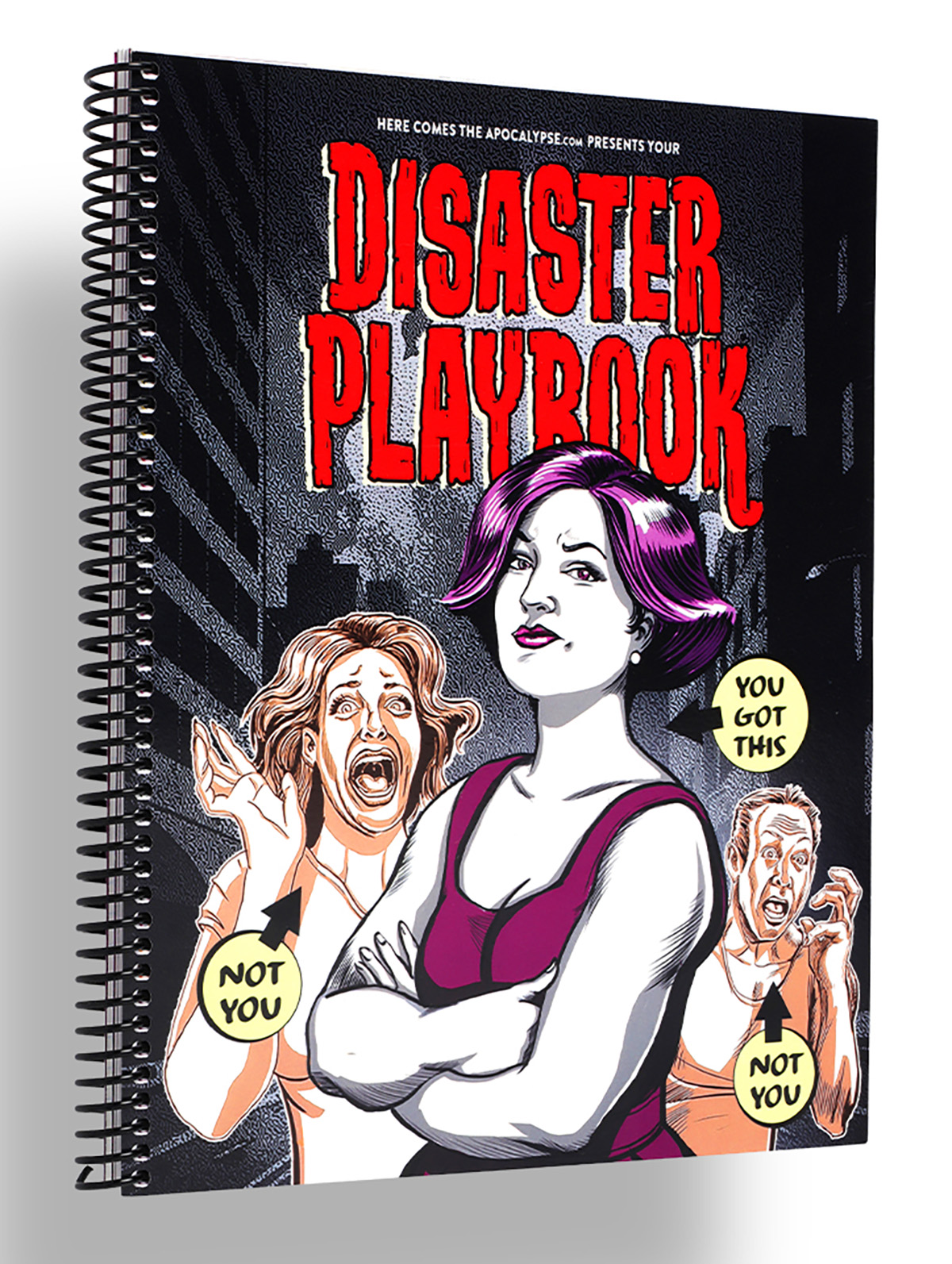
Wickless Vulva Candles
Bold, luxurious, and completely flame-free, CTOAN’s wickless candles melt from beneath on a warmer, releasing subtle, sophisticated fragrances, like sandalwood or lavender. The vulva-shaped wax adds a playful, provocative element to any space –perfect for a bedroom, living room, or anywhere you want elegance with an edge. A gift that celebrates form, intimacy and self-expression, no fire required. $39, CTOANCO.com
Villeroy & Boch Royal Classic Christmas Collection
Every meal is a mini celebration – with whimsy at every place setting – in Villeroy & Boch’s Royal Classic festive dinnerware collection that hits all the right notes. Made from premium German porcelain, it features nostalgic little toys, nutcrackers, and rocking horses in delicate relief, giving your holiday spread a playful but refined twist. Dishwasher- and microwave-safe, it’s luxe without the fuss. Gift a piece to a special someone, or start a collection they’ll use (and show off) for years to come. $22-$363, Villeroy-Boch.com
Greenworks Electric Lawnmower
You a ’hood queen who considers lawn care performance art – or just wants to rule the cul-de-sac in quiet, emission-free glory? Greenworks’ zero-turn electric mower has the muscle of a 24-horsepower gas engine but none of the fumes, drama or maintenance. Six 60V batteries and a 42-inch deck mean you can mow up to two-and-a-half acres on a single charge – then plug in, recharge, and ride again. It’s whisper-quiet, slope-ready, and smooth enough to make you wonder why you ever pushed anything besides your queer agenda. The perfect gift for the homeowner who loves sustainability, symmetry, and showing off their freshly striped yard like that fresh fade you get on Fridays. $5,000, GreenworksTools.com
Molekule Air Purifier
For the friend who treats their space like a sanctuary (or just can’t stand sneezes), the Molekule Air Pro is magic in motion. Covering up to 1,000 square feet, it doesn’t just capture allergens, VOCs, and smoke – it destroys them, leaving your air feeling luxury-clean. FDA-cleared as a Class II medical device, it’s serious science disguised as modern design. Gift it to your city-dwelling, pet-loving, candle-burning friend who likes their living room as pristine as their Instagram feed. $1,015, Molekule.com
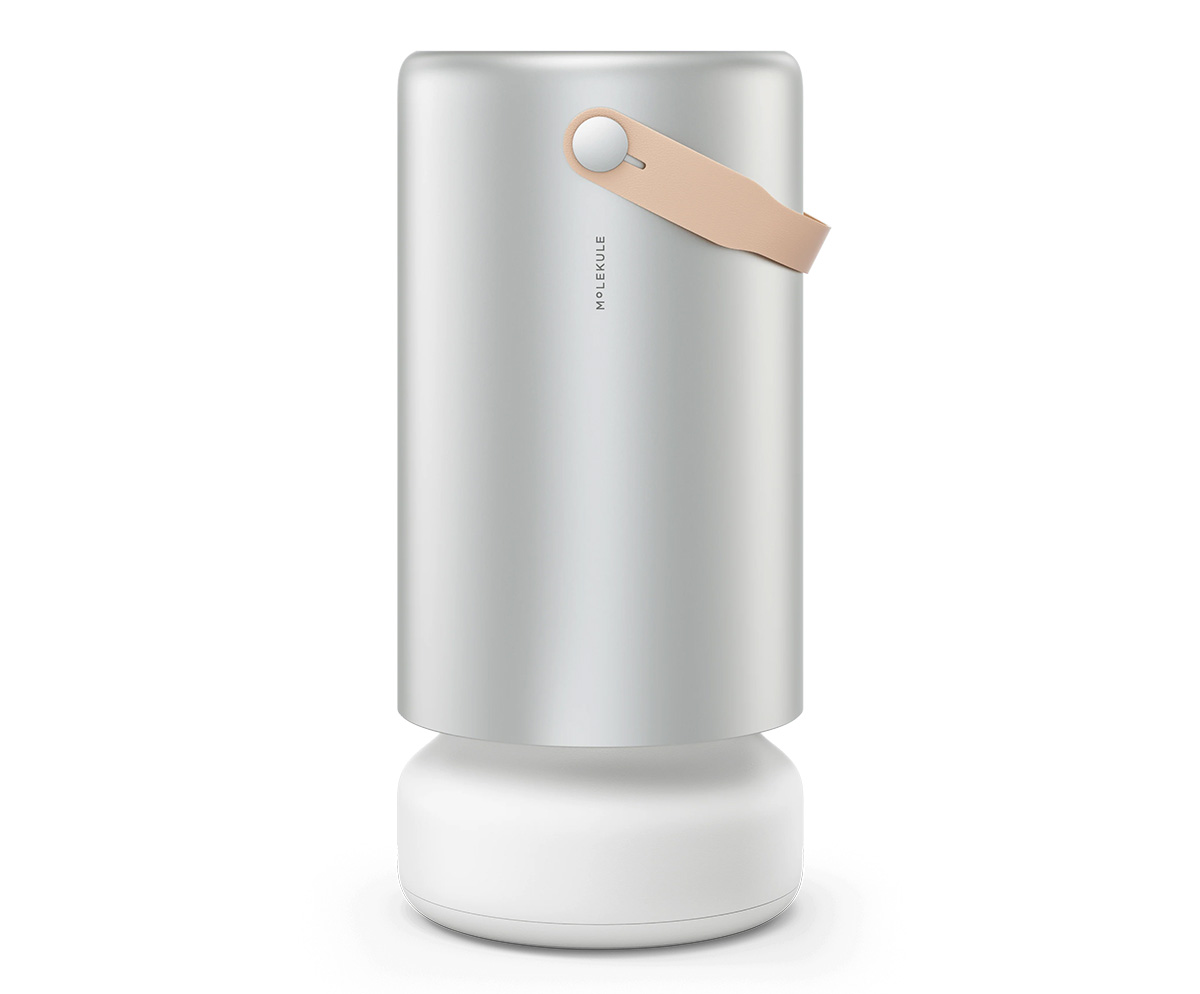
Cipriani Prosecco Gift Set
Effervescent with stone-fruit sweetness and a touch of Italian flair, the Cipriani Bellini & Prosecco gift set brings brunch-level glamour to any day of the week. The Bellini blends rich white-peach purée with sparkling wine, while the dry ’secco keeps things crisp and celebratory. Pop a bottle, pour a flute, and suddenly winter weeknights feel like a party – even with your pants off. $36, TotalWine.com
Woo(e)d Cologne
British GQ recently crowned Woo(e)d by ALTAIA the “Best Date Night Fragrance,” and honestly, they nailed it. Confident without being cocky – smoky gaïac and Atlas cedarwood grounds the room while supple leather and spicy cardamom do all the flirting – it’s a scent that lingers like good conversation and soft candlelight. Gift it to the one who always turns heads – or keep it for yourself and let them come to (and then on) you. $255, BeautyHabit.com

Lococo Cocoa Kit
Keep the run-of-the-mill mugs in the cabinet this Christmas and pull out Lococo’s handcrafted Oaxacan versions that demand you slow down and sip like it matters. Paired with a wooden scoop, rechargeable frother, and Lococo’s signature spice hot-chocolate blend (vegan, gluten-free, with adaptogenic mushrooms), this holiday kit turns Mexi-cocoa into a mini ritual you’ll look forward to. Perfect for anyone who loves a little indulgence with a side of ¡A huevo! energy.
Manta Sleep Mask
Total blackout, zero pressure on the eyes, and Bluetooth speakers built right into the straps, this ain’t your mama’s sleep mask — but it could be. The Manta SOUND sleep mask features C-shaped eye cups that block every hint of light while ultra-thin speakers deliver your favorite white noise, meditation, or late-night playlist straight to your ears. With 24-hour battery life, breathable fabric, and easy-to-adjust sound, it turns any bed (or airplane seat) into a five-star sleep suite. Perfect for anyone who treats shut-eye like an art form (or just wants to escape their roommate’s late-night bingin’ and/or bangin’). $159, MantaSleep.com

Shacklelock Necklace
Turn the industrial-chic vibe of a shackle into a sleek statement. Mi Tesoro’s platinum-plated stainless-steel necklace sits on an 18-inch wheat chain, featuring a shackle-style latch pendant that’s waterproof, tarnish-free, and totally fuss-les. Beyond style, it nods to a classic gesture in the queer leather community: replacing a traditional Master lock with something elegant to quietly signal belonging to someone special. Wear it solo for a minimalist edge or layer it like you mean it; either way this piece locks in both your look and your intentions. $90, MiTesoroJewelry.com
Parkside Flask Mojave Edition
Wine nights get a desert glow-up with Parkside’s limited-edition 750-milliliter all-in-one flask draped in sun-washed bronze and badland hues like sage, sand, and terracotta – with magnetic stemless tumblers that snap on for effortless shareability. It keeps your vino chilled for 24 hours, pours without drips (no tears for spilled rosé, please), and even lets you laser-engrave your own mantra or inside joke. Perfect for picnics, surprise rooftop clinks, or gifting to your favorite wine (or desert) rat. $149, HighCampFlasks.com
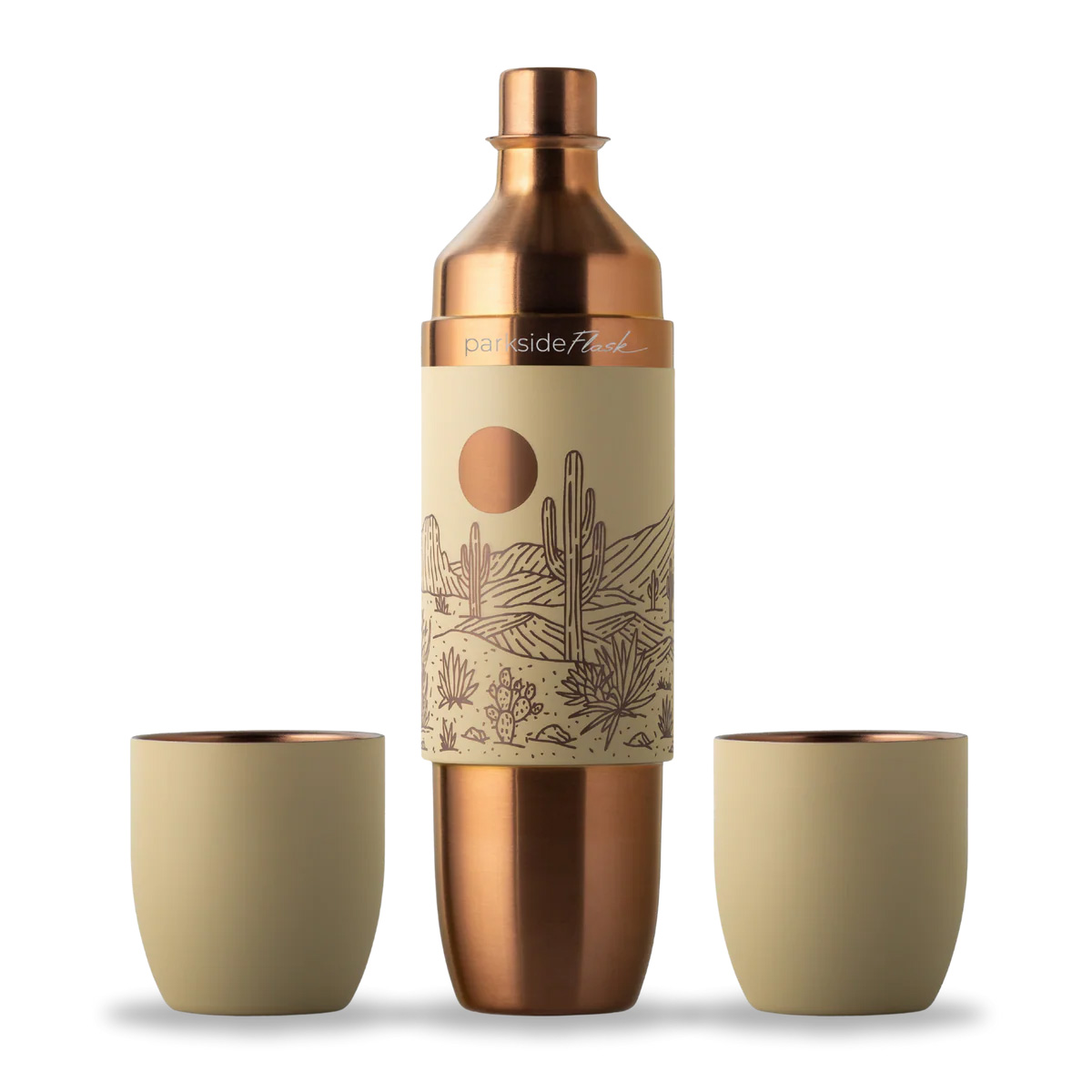
Mikey Rox is an award-winning journalist and LGBT lifestyle expert whose work has published in more than 100 outlets across the world. Connect with him on Instagram @mikeyroxtravels.
a&e features
Meet Mr. Christmas
Hallmark’s Jonathan Bennett on telling gay love stories for mainstream audiences
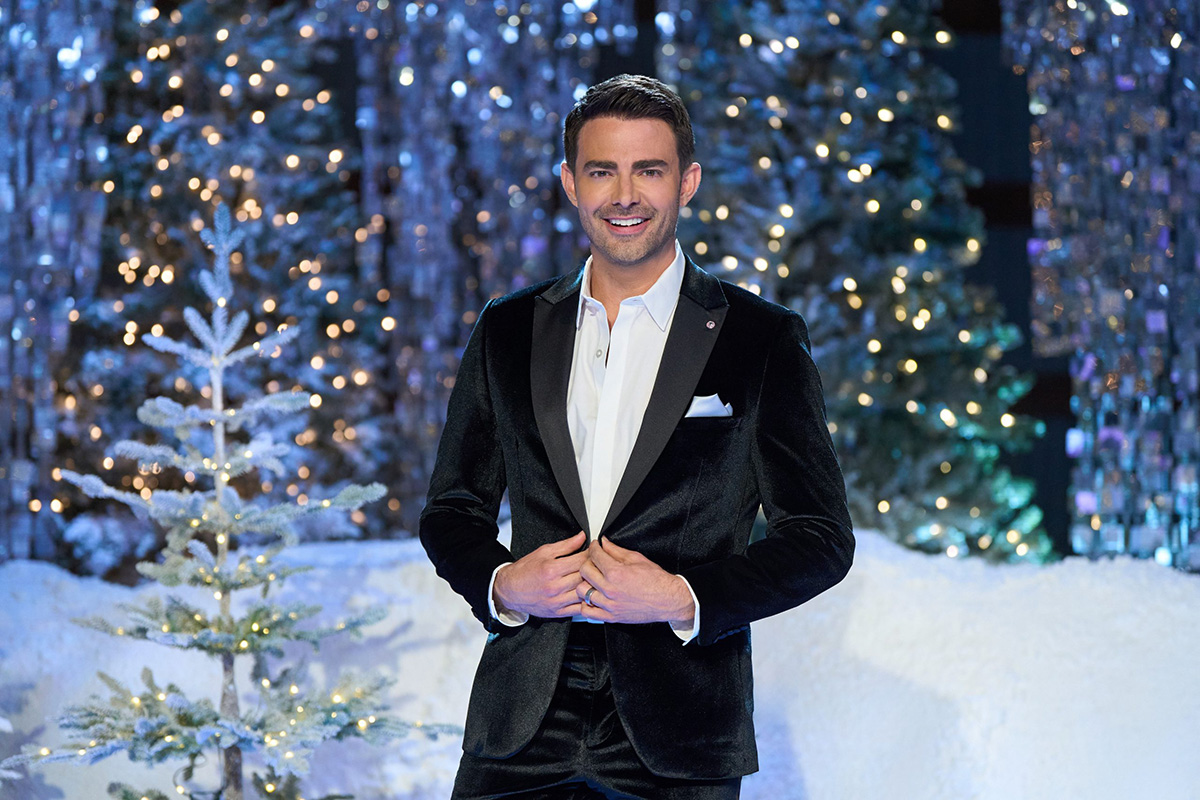
Jonathan Bennett believes there are two kinds of people in the world — those who love Hallmark movies and liars. And in Season 2 of Finding Mr. Christmas, which the Mean Girls star co-created with Ben Roy, Bennett is searching for Hallmark’s next leading man.
“It’s so fun for people because everyone in their life has someone they know that they think should be in Hallmark movies, right? The UPS driver, the barista at the coffee shop, the dentist,” Bennett says. “So we’re testing their acting abilities, we’re testing who they are, but we’re also looking for that star quality — the thing that makes them shine above everyone else. It’s almost something you can’t explain, but we know it when we see it.”
Season 2’s cast includes a former NFL player for the Green Bay Packers, a few actors, and a realtor. The 10 men compete in weekly festive-themed acting challenges, one of which included having to ride a horse and act out a scene with Alison Sweeney. The contestants were chosen from a crop of 360 potential men, and Bennett gives kudos to the show’s Emmy-nominated casting director, Lindsay Liles (The Bachelor, Bachelor in Paradise).
“She has a tough job because she has to find 10 guys that are going to be good reality television, but also have the talent to act, carry a scene, and lead a Hallmark movie eventually,” he says. To be the right fit for a Hallmark leading man, Bennett singles out five key characteristics: you have to be funny, charming, kind, have a sense of humor, and you have to do it all with a big heart.
Of course, Finding Mr. Christmas wouldn’t be Finding Mr. Christmas without its signature eye candy — something Bennett describes as “part of the job” for the contestants. “I can’t believe Hallmark let me get away with this. I dressed them as sexy reindeer and put them in harnesses attached to a cable 30 feet in the air, and they had to do a sexy reindeer photo shoot challenge,” he says with a laugh. “This season is just bigger and bolder than last. People are responding to not only all the craziness that we put them through, but also comparing and contrasting the guys in their acting scenes when we do them back-to-back.”
Season 1 winner Ezra Moreland’s career has been an early testament to the show’s success at finding rising talent. On seeing the show’s first winner flourish, Bennett says, “Now to watch him out in the world, just booking commercial after commercial and shining as an actor and a model, I think the show gave him the wings to do that. He learned so much about himself, and he took all that into his future auditions and casting. He just works nonstop. I’ve never seen an actor book more commercials and modeling gigs in my life.”
Bennett has been a star of plenty of Hallmark movies himself, including the GLAAD-award-winning The Groomsmen: Second Chances, which makes him a fitting host. Among those movies are 2020’s Christmas House, which featured the first same-sex kiss on the network and had a major impact on Bennett’s career as an openly gay man. “Hallmark’s been so great about supporting me in queer storytelling. But again, I don’t make gay movies for gay audiences. I make gay love stories for a broad audience, and that’s a huge difference, right? We’re not telling stories inside baseball that only the gay community will understand.”
He continues, “The backdrop of a Hallmark Christmas movie is very familiar to these people who watch. And so when you tell a gay love story, and you tell it no differently than a straight love story in that space, they’re able to understand. It’s able to change hearts and minds for people who might not have it in their lives.”
While Hallmark has become a major staple of Bennett’s career, he started off wanting to be a Broadway actor. And before the first season of Finding Mr. Christmas aired, Bennett took a break from TV to make his Broadway debut in Spamalot, replacing Michael Urie as Sir Robin and starring alongside Ethan Slater and Alex Brightman.
“That was my dream since I was five years old – then I booked a movie called Mean Girls, and everything kind of changes in your life. You no longer become a person pursuing Broadway, you become a part of pop culture,” Bennett recalls. “And to be honest, when I hit 40, I was like, ‘I’m probably never going to get to live that dream.’ And that’s okay, because I got to do other dreams and other things that were just as cool but different. So I honestly never thought it would happen.”
Bennett is still determined to make his way back on Broadway with the right role — he calls Spamalot the “best experience” of his life, after all — but he’s got another Hallmark show lined up with Murder Mystery House, which he co-created. The show was recently greenlit for development and intends to bring the Hallmark mystery movie to life. “It’s kind of like our version of The Traitors,” Bennett admits.
Looking back on both seasons, Bennett says that what makes Finding Mr. Christmas stand out in the overcrowded reality TV landscape is that everyone involved makes it with heart: “This isn’t a show where you’re going to watch people throw drinks in each other’s faces and get into big fights. The thing that has amazed me so much about this show, the more we’ve done it, is that every season, 10 guys come in as competitors, but they leave as a family and as brothers. That’s something you don’t get on any other network.”
Finding Mr. Christmas airs every Monday on Hallmark through December 20, with episodes available to stream on Hallmark+.
-

 Congress23 hours ago
Congress23 hours agoEXCLUSIVE: George Santos speaks out on prison, Trump pardon, and more
-

 The White House5 days ago
The White House5 days agoTrump’s shocking East Wing amputation—and the painful fallout Americans won’t ignore
-

 Health4 days ago
Health4 days agoThe harsh truth about HIV phobia in gay dating
-

 District of Columbia5 days ago
District of Columbia5 days agoThird LGBTQ candidate running for Ward 1 D.C. Council seat

